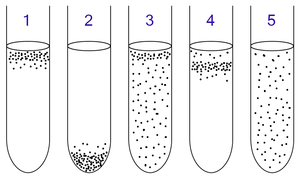Microaerophile
A microaerophile is a microorganism that requires oxygen to survive, but requires environments containing lower levels of oxygen than that are present in the atmosphere (i.e. <21% O2; typically 2–10% O2).[1][2] Many microaerophiles are also capnophiles, requiring an elevated concentration of carbon dioxide (e.g. 10% CO2 in the case of Campylobacter species).[3]

1: Obligate aerobes need oxygen because they cannot ferment or respire anaerobically. They gather at the top of the tube where the oxygen concentration is highest.
2: Obligate anaerobes are poisoned by oxygen, so they gather at the bottom of the tube where the oxygen concentration is lowest.
3: Facultative anaerobes can grow with or without oxygen because they can metabolise energy aerobically or anaerobically. They gather mostly at the top because aerobic respiration generates more ATP than either fermentation or anaerobic respiration.
4: Microaerophiles need oxygen because they cannot ferment or respire anaerobically. However, they are poisoned by high concentrations of oxygen. They gather in the upper part of the test tube but not the very top.
5: Aerotolerant organisms do not require oxygen as they metabolise energy anaerobically. Unlike obligate anaerobes however, they are not poisoned by oxygen. They can be found evenly spread throughout the test tube.
Culture
Microaerophiles can be cultivated in candle jars. Candle jars are containers into which a lit candle is introduced before sealing the container's airtight lid. The candle's flame burns until extinguished by oxygen deprivation, creating a carbon dioxide-rich, oxygen-poor atmosphere.[4] Other methods of creating a microaerobic environment include using a gas-generating pack and gas exchange.[3]
Examples
- Campylobacter species are microaerophilic.[3][5]
- Helicobacter pylori, a species of proteobacteria that has been linked to peptic ulcers and some types of gastritis.[6]
See also
- Aerobic respiration
- Anaerobic respiration
- Facultative anaerobe
- Fermentation
- Obligate aerobe
- Obligate anaerobe
- Oxygenation (environmental)
References
- Hogg, S. (2005). Essential Microbiology (1st ed.). Wiley. pp. 91–107. ISBN 0-471-49754-1.
- Prescott LM, Harley JP, Klein DA (1996). Microbiology (3rd ed.). Wm. C. Brown Publishers. pp. 130–131. ISBN 0-697-29390-4.
- Brooks GF, Carroll KC, Butel JS, Morse SA (2007). Jawetz, Melnick & Adelberg's Medical Microbiology (24th ed.). McGraw Hill. pp. 273–275. ISBN 0-07-128735-3.
- Salim SM, Mandal J, Parija SC (March 2014). "Isolation of Campylobacter from human stool samples". Indian J Med Microbiol. 32 (1): 35–38. doi:10.4103/0255-0857.124294. PMID 24399385.
- Fernie DS, Park RW (August 1977). "The isolation and nature of campylobacters (microaerophilic vibrios) from laboratory and wild rodents". J. Med. Microbiol. 10 (3): 325–9. doi:10.1099/00222615-10-3-325. PMID 330861.
- Cover TL (2012). "Perspectives on methodology for in vitro culture of Helicobacter pylori". Methods Mol Biol. 921: 11–15. doi:10.1007/978-1-62703-005-2_3. PMC 3921885. PMID 23015486.
External links